Parents Dealing with Children’s Addiction
VerifiedAdded on 2023/03/30
|19
|3709
|349
AI Summary
This research talks about the problems that parent from CLAD (Cultural, Linguistic Ability and Diversity) background faces when their kids are addicted to either alcohol or drugs. The immigrants who are forcefully displaced from their own country to a new country because of some kind of problem in their homeland, go through a lot of trouble, they deal with a lot of tension. So there are more stressors for them, these stressors somehow make them more vulnerable to drugs or alcohol. There a lot research which focuses on the drugs that these immigrants take but none of the researches talk about the problems that the parents of these adolescents go through, this research will focus on the these parents and the way they support each other.
Contribute Materials
Your contribution can guide someone’s learning journey. Share your
documents today.

Running Head: PARENTS DEALING CHILDREN’S ADDICTION
Parents Dealing with Children’s Addiction
Name of Student
Name of University
Author Note
Parents Dealing with Children’s Addiction
Name of Student
Name of University
Author Note
Secure Best Marks with AI Grader
Need help grading? Try our AI Grader for instant feedback on your assignments.
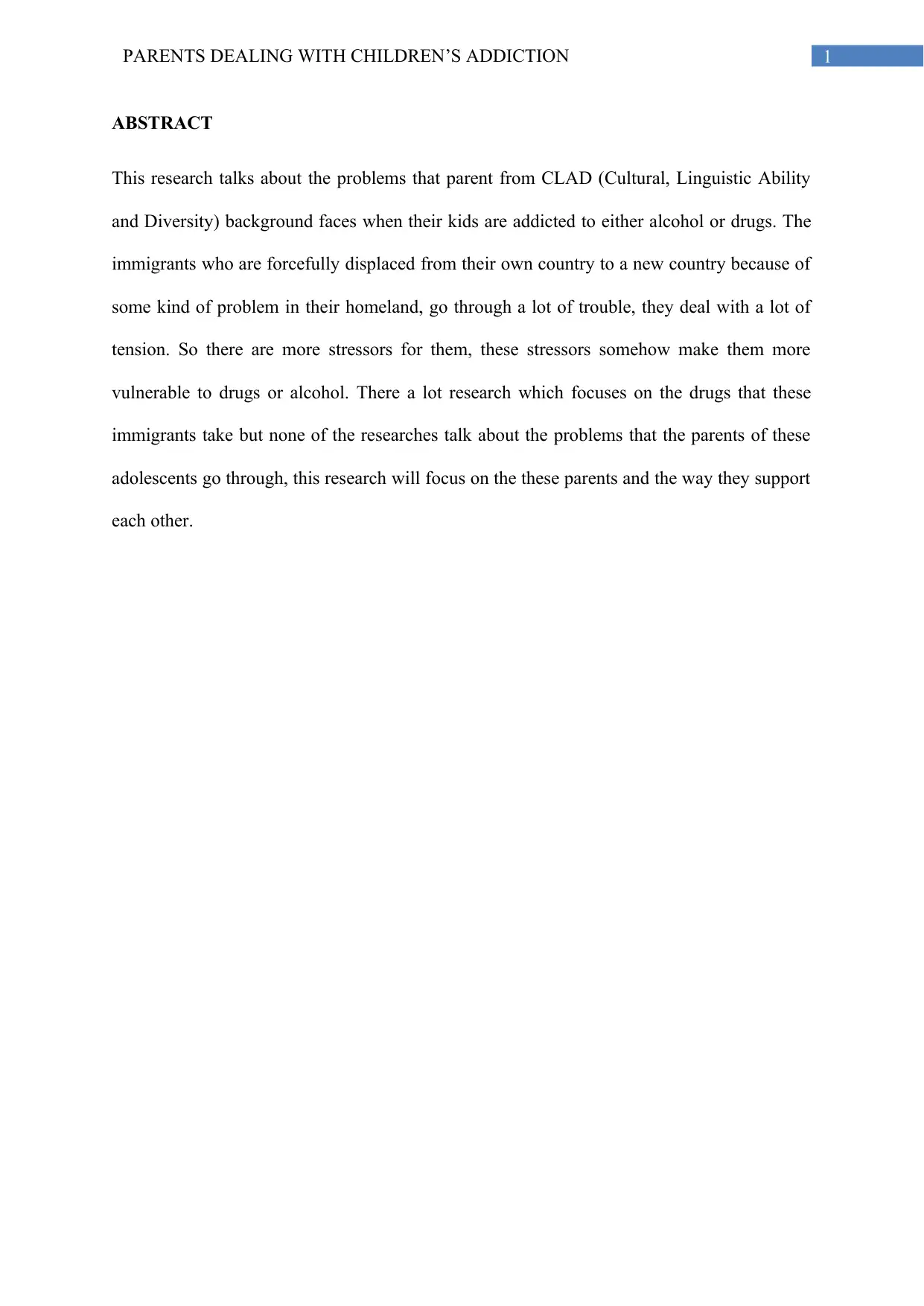
1PARENTS DEALING WITH CHILDREN’S ADDICTION
ABSTRACT
This research talks about the problems that parent from CLAD (Cultural, Linguistic Ability
and Diversity) background faces when their kids are addicted to either alcohol or drugs. The
immigrants who are forcefully displaced from their own country to a new country because of
some kind of problem in their homeland, go through a lot of trouble, they deal with a lot of
tension. So there are more stressors for them, these stressors somehow make them more
vulnerable to drugs or alcohol. There a lot research which focuses on the drugs that these
immigrants take but none of the researches talk about the problems that the parents of these
adolescents go through, this research will focus on the these parents and the way they support
each other.
ABSTRACT
This research talks about the problems that parent from CLAD (Cultural, Linguistic Ability
and Diversity) background faces when their kids are addicted to either alcohol or drugs. The
immigrants who are forcefully displaced from their own country to a new country because of
some kind of problem in their homeland, go through a lot of trouble, they deal with a lot of
tension. So there are more stressors for them, these stressors somehow make them more
vulnerable to drugs or alcohol. There a lot research which focuses on the drugs that these
immigrants take but none of the researches talk about the problems that the parents of these
adolescents go through, this research will focus on the these parents and the way they support
each other.
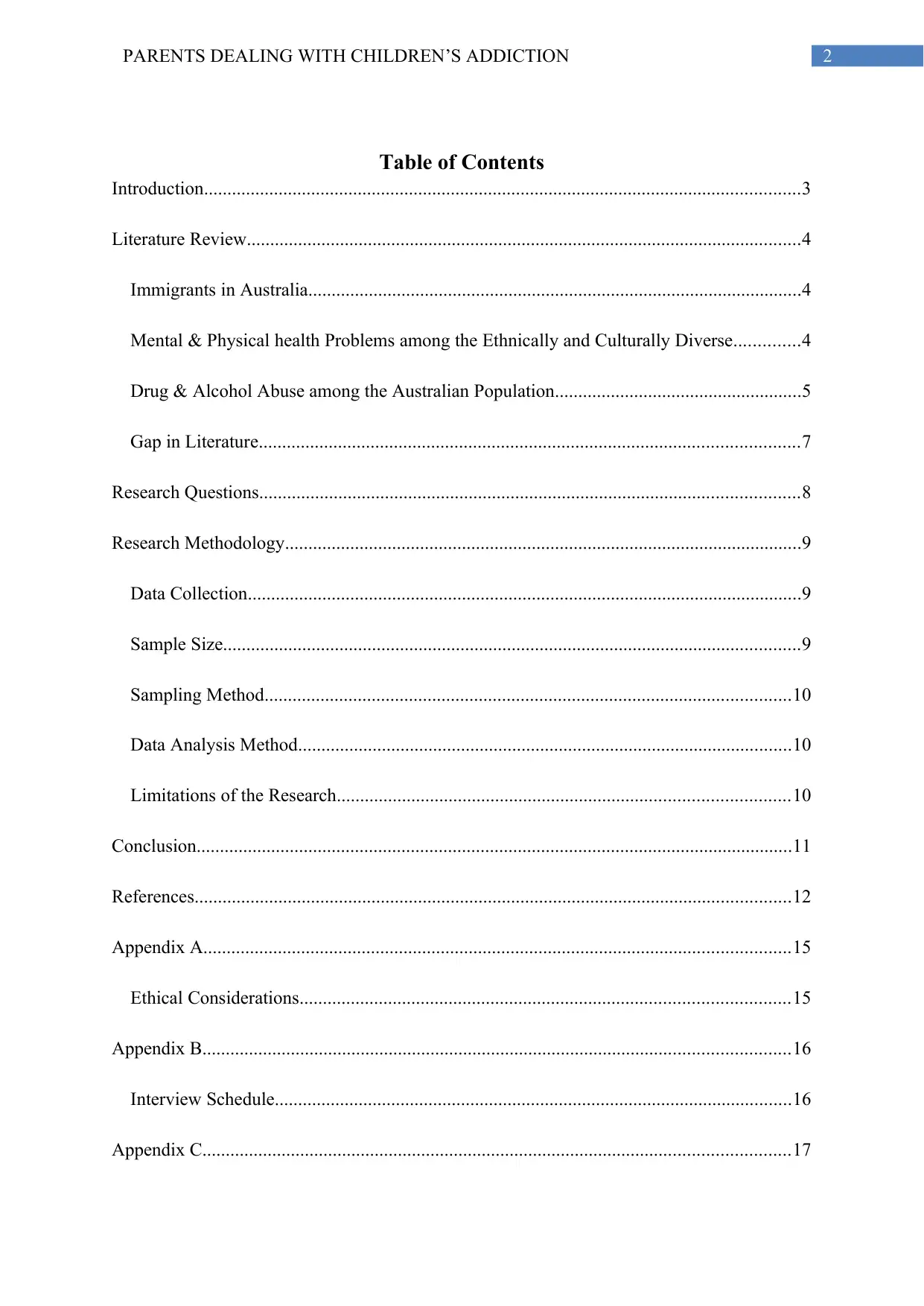
2PARENTS DEALING WITH CHILDREN’S ADDICTION
Table of Contents
Introduction................................................................................................................................3
Literature Review.......................................................................................................................4
Immigrants in Australia..........................................................................................................4
Mental & Physical health Problems among the Ethnically and Culturally Diverse..............4
Drug & Alcohol Abuse among the Australian Population.....................................................5
Gap in Literature....................................................................................................................7
Research Questions....................................................................................................................8
Research Methodology...............................................................................................................9
Data Collection.......................................................................................................................9
Sample Size............................................................................................................................9
Sampling Method.................................................................................................................10
Data Analysis Method..........................................................................................................10
Limitations of the Research.................................................................................................10
Conclusion................................................................................................................................11
References................................................................................................................................12
Appendix A..............................................................................................................................15
Ethical Considerations.........................................................................................................15
Appendix B..............................................................................................................................16
Interview Schedule...............................................................................................................16
Appendix C..............................................................................................................................17
Table of Contents
Introduction................................................................................................................................3
Literature Review.......................................................................................................................4
Immigrants in Australia..........................................................................................................4
Mental & Physical health Problems among the Ethnically and Culturally Diverse..............4
Drug & Alcohol Abuse among the Australian Population.....................................................5
Gap in Literature....................................................................................................................7
Research Questions....................................................................................................................8
Research Methodology...............................................................................................................9
Data Collection.......................................................................................................................9
Sample Size............................................................................................................................9
Sampling Method.................................................................................................................10
Data Analysis Method..........................................................................................................10
Limitations of the Research.................................................................................................10
Conclusion................................................................................................................................11
References................................................................................................................................12
Appendix A..............................................................................................................................15
Ethical Considerations.........................................................................................................15
Appendix B..............................................................................................................................16
Interview Schedule...............................................................................................................16
Appendix C..............................................................................................................................17

3PARENTS DEALING WITH CHILDREN’S ADDICTION
GANTT chart.......................................................................................................................17
Introduction
Every year 60-70,000 refugees take asylum in Western countries, Australia is among
them. Each year Australia opens its gates for 5-10,000 refugees, making the country one of
the top refugee giving countries of the world. Among these refugees, 51 million of those
immigrants are displaced forcibly from their homelands because of some civil unrest or war
or conflict that has affected their own country. These refugees and immigrants experience a
high degree of trauma because taking asylum in a new country makes it difficult for them to
get access to food, water and a safe place to stay. This trauma can be exaggerated as
sometimes these immigrants lose their families while being displaced, sometimes they
witness an unbearable amount of violence, and they have to go through poverty even if they
were from an economically well-to-do family in their homeland. This sometimes leads them
to resort to alcohol or drug abuse. Studies have shown that drug and alcohol abuse among the
immigrant population is more than that of the host population. The ethnic and cultural
minorities are more prone to substance abuse and alcoholism as the experiences that they go
through are severe and there is a complete disruption of their lives which forces them to
resort to alcohol and drugs. In Australia, the young boys and girls who are of African descent
especially the Sudanese youth have been identifies in some studies as the ‘problem group’.
They are reportedly using drugs and drinking alcohol on a larger amount, these young
population experiences more mental health issues than any other population. It is of prime
importance to understand the reaction of the parents in these cases. When the children
experience these problems, the parents of these ethnically diverse families also go through the
GANTT chart.......................................................................................................................17
Introduction
Every year 60-70,000 refugees take asylum in Western countries, Australia is among
them. Each year Australia opens its gates for 5-10,000 refugees, making the country one of
the top refugee giving countries of the world. Among these refugees, 51 million of those
immigrants are displaced forcibly from their homelands because of some civil unrest or war
or conflict that has affected their own country. These refugees and immigrants experience a
high degree of trauma because taking asylum in a new country makes it difficult for them to
get access to food, water and a safe place to stay. This trauma can be exaggerated as
sometimes these immigrants lose their families while being displaced, sometimes they
witness an unbearable amount of violence, and they have to go through poverty even if they
were from an economically well-to-do family in their homeland. This sometimes leads them
to resort to alcohol or drug abuse. Studies have shown that drug and alcohol abuse among the
immigrant population is more than that of the host population. The ethnic and cultural
minorities are more prone to substance abuse and alcoholism as the experiences that they go
through are severe and there is a complete disruption of their lives which forces them to
resort to alcohol and drugs. In Australia, the young boys and girls who are of African descent
especially the Sudanese youth have been identifies in some studies as the ‘problem group’.
They are reportedly using drugs and drinking alcohol on a larger amount, these young
population experiences more mental health issues than any other population. It is of prime
importance to understand the reaction of the parents in these cases. When the children
experience these problems, the parents of these ethnically diverse families also go through the
Secure Best Marks with AI Grader
Need help grading? Try our AI Grader for instant feedback on your assignments.
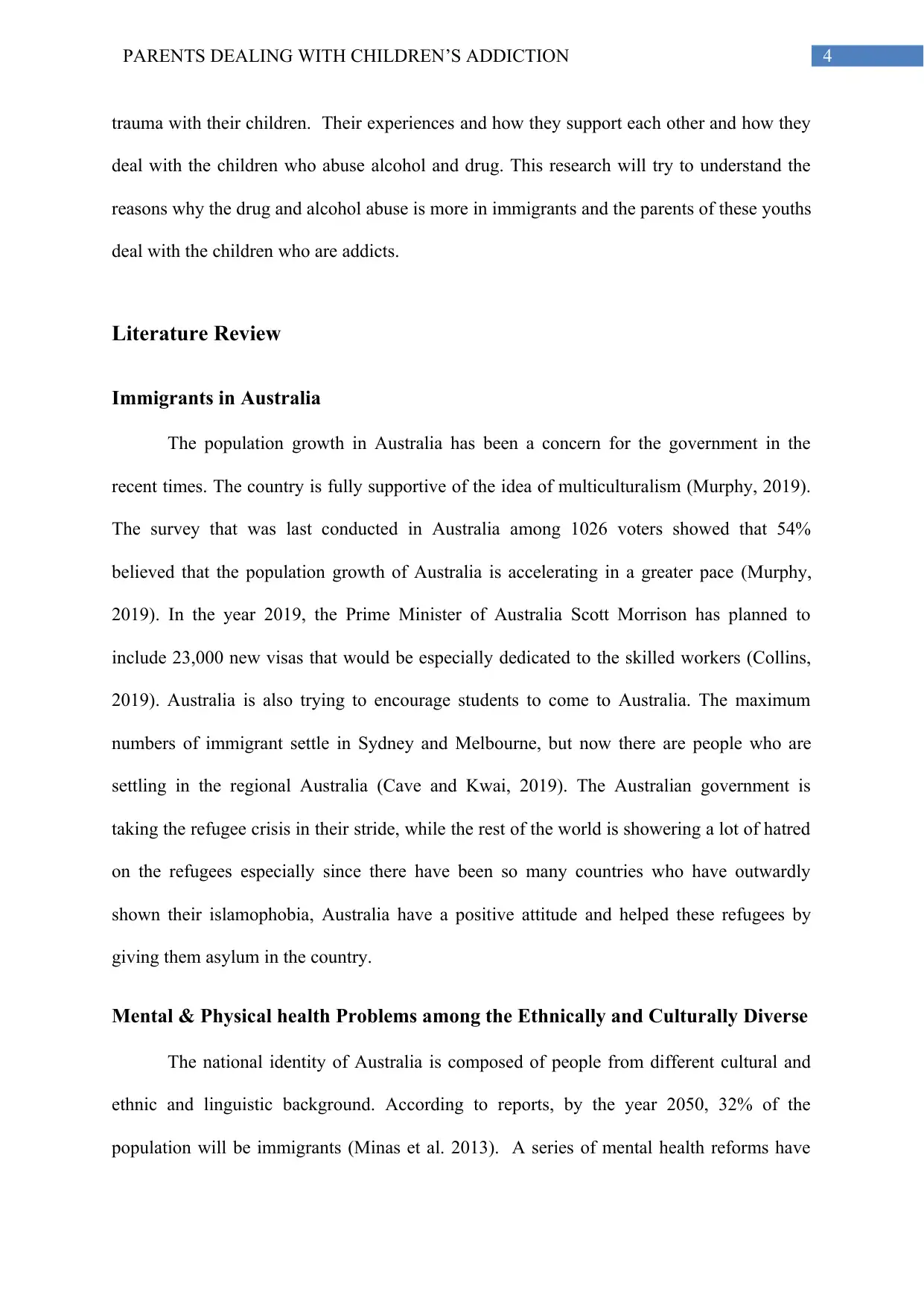
4PARENTS DEALING WITH CHILDREN’S ADDICTION
trauma with their children. Their experiences and how they support each other and how they
deal with the children who abuse alcohol and drug. This research will try to understand the
reasons why the drug and alcohol abuse is more in immigrants and the parents of these youths
deal with the children who are addicts.
Literature Review
Immigrants in Australia
The population growth in Australia has been a concern for the government in the
recent times. The country is fully supportive of the idea of multiculturalism (Murphy, 2019).
The survey that was last conducted in Australia among 1026 voters showed that 54%
believed that the population growth of Australia is accelerating in a greater pace (Murphy,
2019). In the year 2019, the Prime Minister of Australia Scott Morrison has planned to
include 23,000 new visas that would be especially dedicated to the skilled workers (Collins,
2019). Australia is also trying to encourage students to come to Australia. The maximum
numbers of immigrant settle in Sydney and Melbourne, but now there are people who are
settling in the regional Australia (Cave and Kwai, 2019). The Australian government is
taking the refugee crisis in their stride, while the rest of the world is showering a lot of hatred
on the refugees especially since there have been so many countries who have outwardly
shown their islamophobia, Australia have a positive attitude and helped these refugees by
giving them asylum in the country.
Mental & Physical health Problems among the Ethnically and Culturally Diverse
The national identity of Australia is composed of people from different cultural and
ethnic and linguistic background. According to reports, by the year 2050, 32% of the
population will be immigrants (Minas et al. 2013). A series of mental health reforms have
trauma with their children. Their experiences and how they support each other and how they
deal with the children who abuse alcohol and drug. This research will try to understand the
reasons why the drug and alcohol abuse is more in immigrants and the parents of these youths
deal with the children who are addicts.
Literature Review
Immigrants in Australia
The population growth in Australia has been a concern for the government in the
recent times. The country is fully supportive of the idea of multiculturalism (Murphy, 2019).
The survey that was last conducted in Australia among 1026 voters showed that 54%
believed that the population growth of Australia is accelerating in a greater pace (Murphy,
2019). In the year 2019, the Prime Minister of Australia Scott Morrison has planned to
include 23,000 new visas that would be especially dedicated to the skilled workers (Collins,
2019). Australia is also trying to encourage students to come to Australia. The maximum
numbers of immigrant settle in Sydney and Melbourne, but now there are people who are
settling in the regional Australia (Cave and Kwai, 2019). The Australian government is
taking the refugee crisis in their stride, while the rest of the world is showering a lot of hatred
on the refugees especially since there have been so many countries who have outwardly
shown their islamophobia, Australia have a positive attitude and helped these refugees by
giving them asylum in the country.
Mental & Physical health Problems among the Ethnically and Culturally Diverse
The national identity of Australia is composed of people from different cultural and
ethnic and linguistic background. According to reports, by the year 2050, 32% of the
population will be immigrants (Minas et al. 2013). A series of mental health reforms have

5PARENTS DEALING WITH CHILDREN’S ADDICTION
been brought into effect by the government but the challenges that these culturally, ethnically
and linguistically different people present have not yet been met by the government. There is
another concern that the policies that are implemented by the government are at all useful for
the immigrant population. The researches that are done on the mental health problems in
Australia, they rarely take into account the problems that the immigrant populations deal with
(Minas et al. 2013). There are various mental health problems that the immigrant population
go through as the situations that they go through is extreme and the host country implements
a lot of policies to help but the question remains that whether these people are aware of the
policies and whether they enjoy the benefits of the policies. Other researchers have also
looked into the factor that whether the CLAD (Cultural, Linguistic Ability and Diversity)
men and women are more ignored or given treatment in health care services compared to the
Australian natives (Straiton et al. 2014). The results showed that the treatment given to the
CLAD people were not different from that of the Australian natives but the problem lies in
the fact that the CLAD people are more prone to depression and other mental health issues
compared to that of the native Australians (Straiton et al. 2014).
There is a government wing of Australia known as the Australian Institute of Family
Studies which deals with the gathering information about the CLAD adolescents (aifs.gov.au
2019). These studies try to understand whether the kids belonging from CLAD background
face any kind of difficulties in social and emotional development and the way their school
supports in integrating them. The results of these data showed that there were children who
were left unsupervised or they were left with their elder sibling (aifs.gov.au 2019).
Unsupervised children would wander out of their houses and this is considered dangerous by
local authorities (aifs.gov.au 2019). Such type of behaviors was found in the CLAD children
and this according to the reports sometimes has negative mental health impact on the kids.
been brought into effect by the government but the challenges that these culturally, ethnically
and linguistically different people present have not yet been met by the government. There is
another concern that the policies that are implemented by the government are at all useful for
the immigrant population. The researches that are done on the mental health problems in
Australia, they rarely take into account the problems that the immigrant populations deal with
(Minas et al. 2013). There are various mental health problems that the immigrant population
go through as the situations that they go through is extreme and the host country implements
a lot of policies to help but the question remains that whether these people are aware of the
policies and whether they enjoy the benefits of the policies. Other researchers have also
looked into the factor that whether the CLAD (Cultural, Linguistic Ability and Diversity)
men and women are more ignored or given treatment in health care services compared to the
Australian natives (Straiton et al. 2014). The results showed that the treatment given to the
CLAD people were not different from that of the Australian natives but the problem lies in
the fact that the CLAD people are more prone to depression and other mental health issues
compared to that of the native Australians (Straiton et al. 2014).
There is a government wing of Australia known as the Australian Institute of Family
Studies which deals with the gathering information about the CLAD adolescents (aifs.gov.au
2019). These studies try to understand whether the kids belonging from CLAD background
face any kind of difficulties in social and emotional development and the way their school
supports in integrating them. The results of these data showed that there were children who
were left unsupervised or they were left with their elder sibling (aifs.gov.au 2019).
Unsupervised children would wander out of their houses and this is considered dangerous by
local authorities (aifs.gov.au 2019). Such type of behaviors was found in the CLAD children
and this according to the reports sometimes has negative mental health impact on the kids.
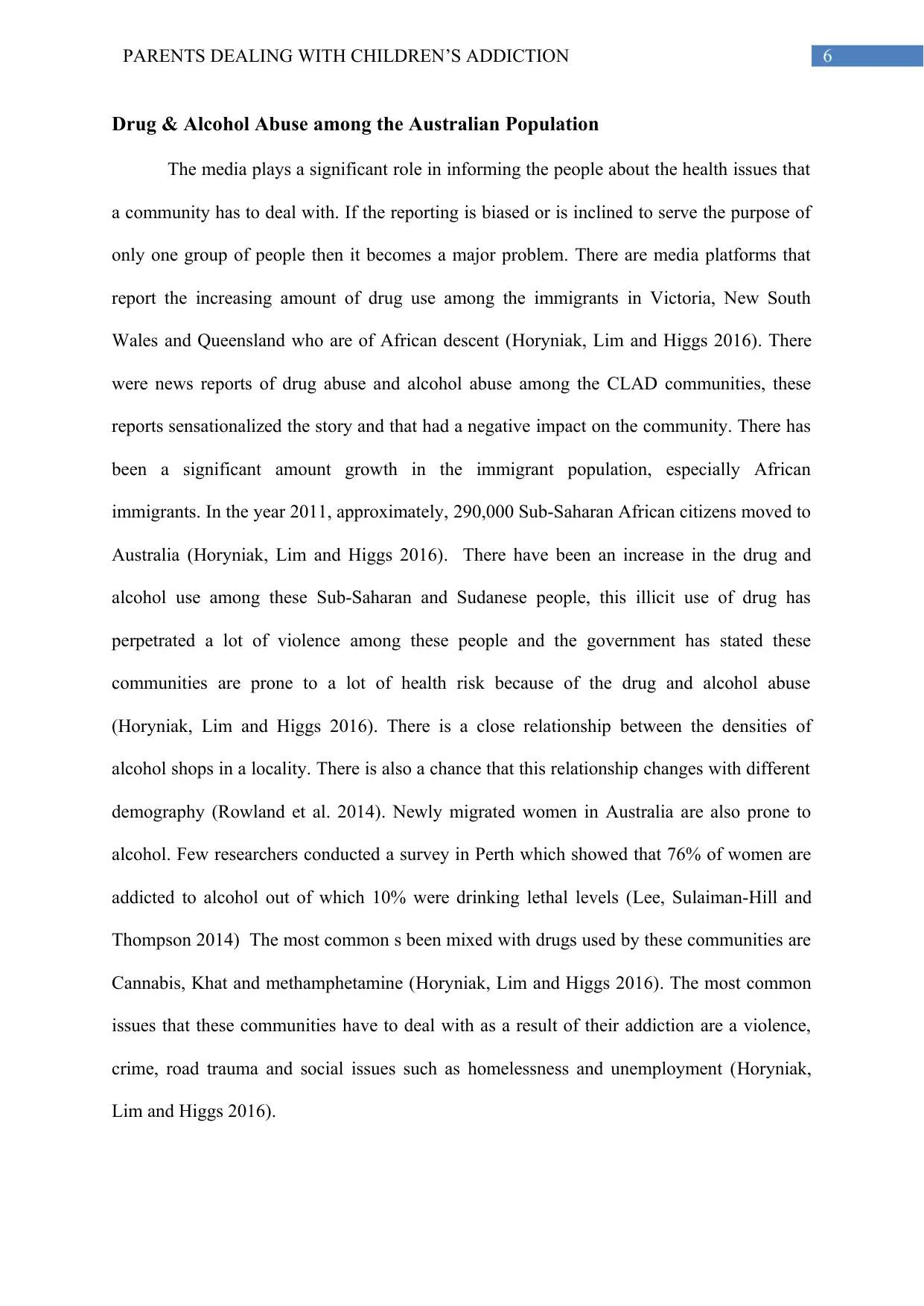
6PARENTS DEALING WITH CHILDREN’S ADDICTION
Drug & Alcohol Abuse among the Australian Population
The media plays a significant role in informing the people about the health issues that
a community has to deal with. If the reporting is biased or is inclined to serve the purpose of
only one group of people then it becomes a major problem. There are media platforms that
report the increasing amount of drug use among the immigrants in Victoria, New South
Wales and Queensland who are of African descent (Horyniak, Lim and Higgs 2016). There
were news reports of drug abuse and alcohol abuse among the CLAD communities, these
reports sensationalized the story and that had a negative impact on the community. There has
been a significant amount growth in the immigrant population, especially African
immigrants. In the year 2011, approximately, 290,000 Sub-Saharan African citizens moved to
Australia (Horyniak, Lim and Higgs 2016). There have been an increase in the drug and
alcohol use among these Sub-Saharan and Sudanese people, this illicit use of drug has
perpetrated a lot of violence among these people and the government has stated these
communities are prone to a lot of health risk because of the drug and alcohol abuse
(Horyniak, Lim and Higgs 2016). There is a close relationship between the densities of
alcohol shops in a locality. There is also a chance that this relationship changes with different
demography (Rowland et al. 2014). Newly migrated women in Australia are also prone to
alcohol. Few researchers conducted a survey in Perth which showed that 76% of women are
addicted to alcohol out of which 10% were drinking lethal levels (Lee, Sulaiman-Hill and
Thompson 2014) The most common s been mixed with drugs used by these communities are
Cannabis, Khat and methamphetamine (Horyniak, Lim and Higgs 2016). The most common
issues that these communities have to deal with as a result of their addiction are a violence,
crime, road trauma and social issues such as homelessness and unemployment (Horyniak,
Lim and Higgs 2016).
Drug & Alcohol Abuse among the Australian Population
The media plays a significant role in informing the people about the health issues that
a community has to deal with. If the reporting is biased or is inclined to serve the purpose of
only one group of people then it becomes a major problem. There are media platforms that
report the increasing amount of drug use among the immigrants in Victoria, New South
Wales and Queensland who are of African descent (Horyniak, Lim and Higgs 2016). There
were news reports of drug abuse and alcohol abuse among the CLAD communities, these
reports sensationalized the story and that had a negative impact on the community. There has
been a significant amount growth in the immigrant population, especially African
immigrants. In the year 2011, approximately, 290,000 Sub-Saharan African citizens moved to
Australia (Horyniak, Lim and Higgs 2016). There have been an increase in the drug and
alcohol use among these Sub-Saharan and Sudanese people, this illicit use of drug has
perpetrated a lot of violence among these people and the government has stated these
communities are prone to a lot of health risk because of the drug and alcohol abuse
(Horyniak, Lim and Higgs 2016). There is a close relationship between the densities of
alcohol shops in a locality. There is also a chance that this relationship changes with different
demography (Rowland et al. 2014). Newly migrated women in Australia are also prone to
alcohol. Few researchers conducted a survey in Perth which showed that 76% of women are
addicted to alcohol out of which 10% were drinking lethal levels (Lee, Sulaiman-Hill and
Thompson 2014) The most common s been mixed with drugs used by these communities are
Cannabis, Khat and methamphetamine (Horyniak, Lim and Higgs 2016). The most common
issues that these communities have to deal with as a result of their addiction are a violence,
crime, road trauma and social issues such as homelessness and unemployment (Horyniak,
Lim and Higgs 2016).
Paraphrase This Document
Need a fresh take? Get an instant paraphrase of this document with our AI Paraphraser
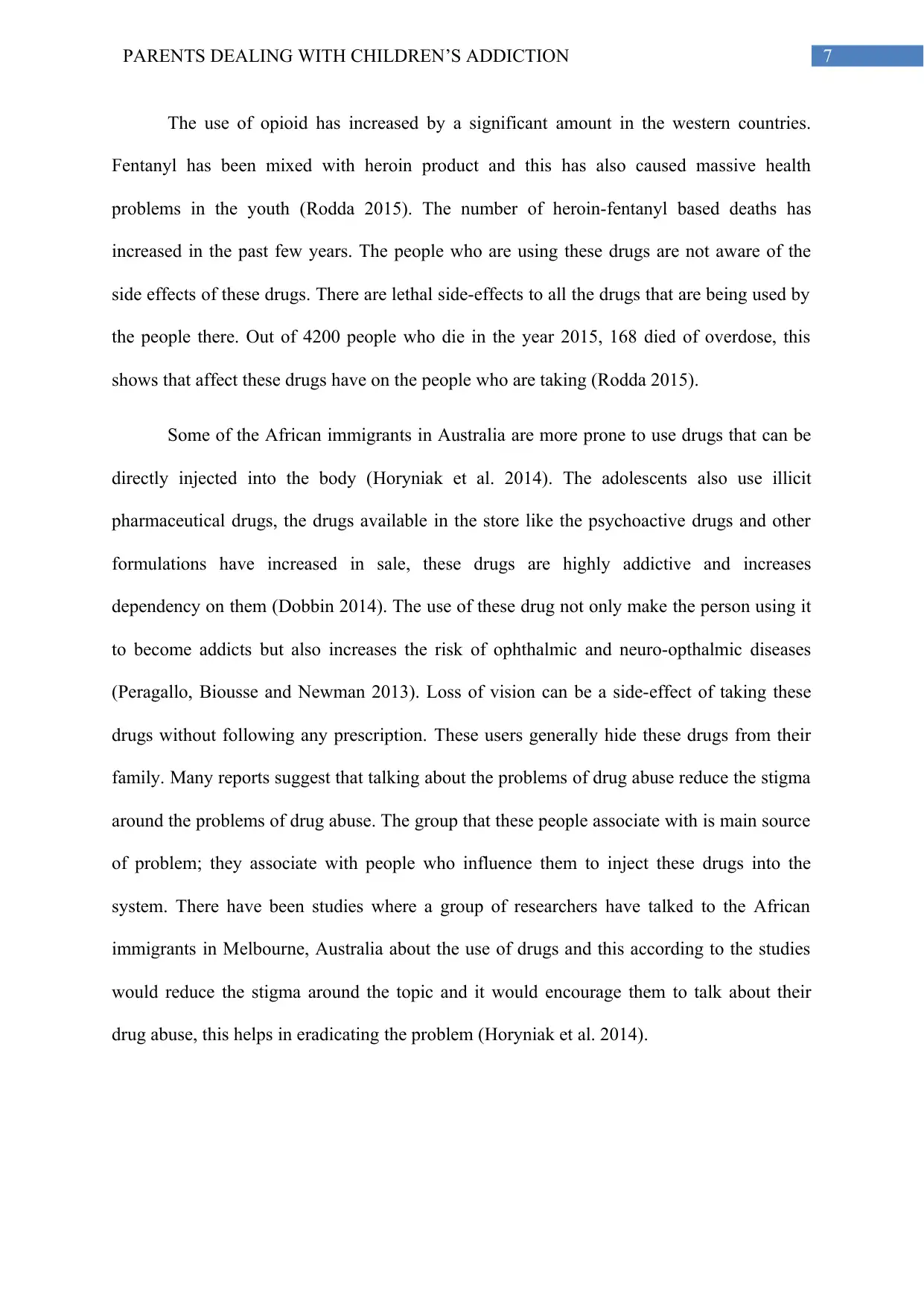
7PARENTS DEALING WITH CHILDREN’S ADDICTION
The use of opioid has increased by a significant amount in the western countries.
Fentanyl has been mixed with heroin product and this has also caused massive health
problems in the youth (Rodda 2015). The number of heroin-fentanyl based deaths has
increased in the past few years. The people who are using these drugs are not aware of the
side effects of these drugs. There are lethal side-effects to all the drugs that are being used by
the people there. Out of 4200 people who die in the year 2015, 168 died of overdose, this
shows that affect these drugs have on the people who are taking (Rodda 2015).
Some of the African immigrants in Australia are more prone to use drugs that can be
directly injected into the body (Horyniak et al. 2014). The adolescents also use illicit
pharmaceutical drugs, the drugs available in the store like the psychoactive drugs and other
formulations have increased in sale, these drugs are highly addictive and increases
dependency on them (Dobbin 2014). The use of these drug not only make the person using it
to become addicts but also increases the risk of ophthalmic and neuro-opthalmic diseases
(Peragallo, Biousse and Newman 2013). Loss of vision can be a side-effect of taking these
drugs without following any prescription. These users generally hide these drugs from their
family. Many reports suggest that talking about the problems of drug abuse reduce the stigma
around the problems of drug abuse. The group that these people associate with is main source
of problem; they associate with people who influence them to inject these drugs into the
system. There have been studies where a group of researchers have talked to the African
immigrants in Melbourne, Australia about the use of drugs and this according to the studies
would reduce the stigma around the topic and it would encourage them to talk about their
drug abuse, this helps in eradicating the problem (Horyniak et al. 2014).
The use of opioid has increased by a significant amount in the western countries.
Fentanyl has been mixed with heroin product and this has also caused massive health
problems in the youth (Rodda 2015). The number of heroin-fentanyl based deaths has
increased in the past few years. The people who are using these drugs are not aware of the
side effects of these drugs. There are lethal side-effects to all the drugs that are being used by
the people there. Out of 4200 people who die in the year 2015, 168 died of overdose, this
shows that affect these drugs have on the people who are taking (Rodda 2015).
Some of the African immigrants in Australia are more prone to use drugs that can be
directly injected into the body (Horyniak et al. 2014). The adolescents also use illicit
pharmaceutical drugs, the drugs available in the store like the psychoactive drugs and other
formulations have increased in sale, these drugs are highly addictive and increases
dependency on them (Dobbin 2014). The use of these drug not only make the person using it
to become addicts but also increases the risk of ophthalmic and neuro-opthalmic diseases
(Peragallo, Biousse and Newman 2013). Loss of vision can be a side-effect of taking these
drugs without following any prescription. These users generally hide these drugs from their
family. Many reports suggest that talking about the problems of drug abuse reduce the stigma
around the problems of drug abuse. The group that these people associate with is main source
of problem; they associate with people who influence them to inject these drugs into the
system. There have been studies where a group of researchers have talked to the African
immigrants in Melbourne, Australia about the use of drugs and this according to the studies
would reduce the stigma around the topic and it would encourage them to talk about their
drug abuse, this helps in eradicating the problem (Horyniak et al. 2014).
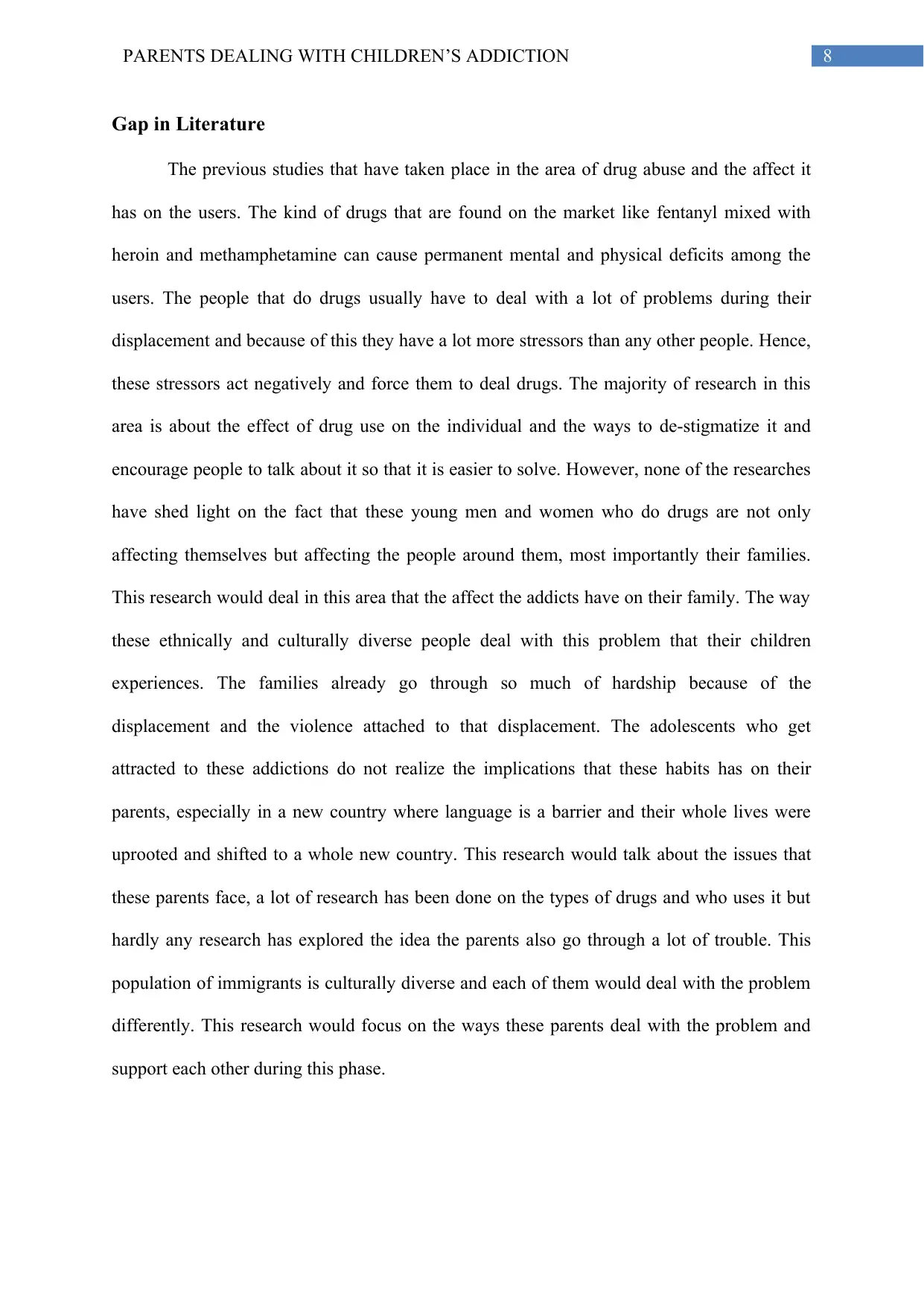
8PARENTS DEALING WITH CHILDREN’S ADDICTION
Gap in Literature
The previous studies that have taken place in the area of drug abuse and the affect it
has on the users. The kind of drugs that are found on the market like fentanyl mixed with
heroin and methamphetamine can cause permanent mental and physical deficits among the
users. The people that do drugs usually have to deal with a lot of problems during their
displacement and because of this they have a lot more stressors than any other people. Hence,
these stressors act negatively and force them to deal drugs. The majority of research in this
area is about the effect of drug use on the individual and the ways to de-stigmatize it and
encourage people to talk about it so that it is easier to solve. However, none of the researches
have shed light on the fact that these young men and women who do drugs are not only
affecting themselves but affecting the people around them, most importantly their families.
This research would deal in this area that the affect the addicts have on their family. The way
these ethnically and culturally diverse people deal with this problem that their children
experiences. The families already go through so much of hardship because of the
displacement and the violence attached to that displacement. The adolescents who get
attracted to these addictions do not realize the implications that these habits has on their
parents, especially in a new country where language is a barrier and their whole lives were
uprooted and shifted to a whole new country. This research would talk about the issues that
these parents face, a lot of research has been done on the types of drugs and who uses it but
hardly any research has explored the idea the parents also go through a lot of trouble. This
population of immigrants is culturally diverse and each of them would deal with the problem
differently. This research would focus on the ways these parents deal with the problem and
support each other during this phase.
Gap in Literature
The previous studies that have taken place in the area of drug abuse and the affect it
has on the users. The kind of drugs that are found on the market like fentanyl mixed with
heroin and methamphetamine can cause permanent mental and physical deficits among the
users. The people that do drugs usually have to deal with a lot of problems during their
displacement and because of this they have a lot more stressors than any other people. Hence,
these stressors act negatively and force them to deal drugs. The majority of research in this
area is about the effect of drug use on the individual and the ways to de-stigmatize it and
encourage people to talk about it so that it is easier to solve. However, none of the researches
have shed light on the fact that these young men and women who do drugs are not only
affecting themselves but affecting the people around them, most importantly their families.
This research would deal in this area that the affect the addicts have on their family. The way
these ethnically and culturally diverse people deal with this problem that their children
experiences. The families already go through so much of hardship because of the
displacement and the violence attached to that displacement. The adolescents who get
attracted to these addictions do not realize the implications that these habits has on their
parents, especially in a new country where language is a barrier and their whole lives were
uprooted and shifted to a whole new country. This research would talk about the issues that
these parents face, a lot of research has been done on the types of drugs and who uses it but
hardly any research has explored the idea the parents also go through a lot of trouble. This
population of immigrants is culturally diverse and each of them would deal with the problem
differently. This research would focus on the ways these parents deal with the problem and
support each other during this phase.
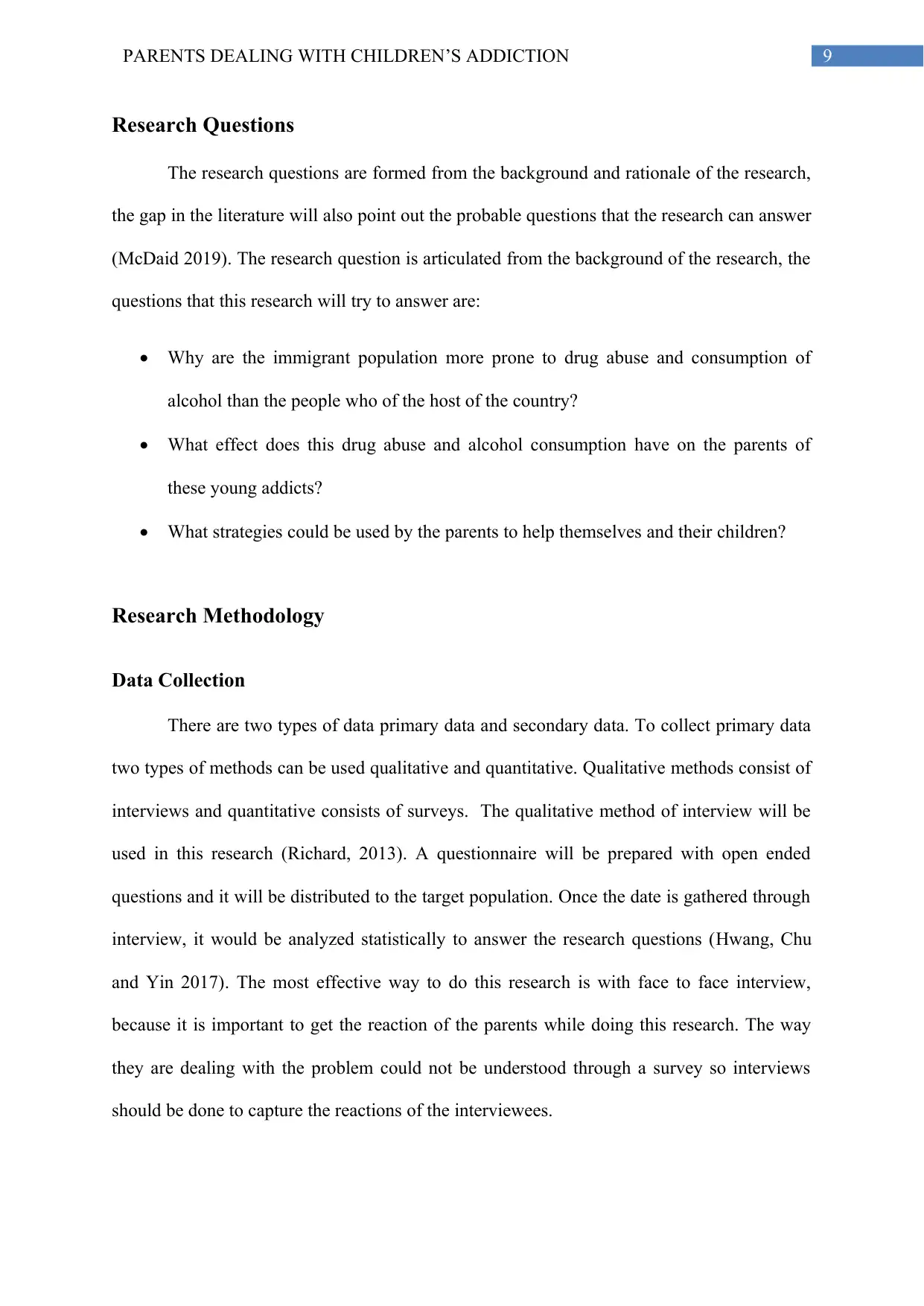
9PARENTS DEALING WITH CHILDREN’S ADDICTION
Research Questions
The research questions are formed from the background and rationale of the research,
the gap in the literature will also point out the probable questions that the research can answer
(McDaid 2019). The research question is articulated from the background of the research, the
questions that this research will try to answer are:
Why are the immigrant population more prone to drug abuse and consumption of
alcohol than the people who of the host of the country?
What effect does this drug abuse and alcohol consumption have on the parents of
these young addicts?
What strategies could be used by the parents to help themselves and their children?
Research Methodology
Data Collection
There are two types of data primary data and secondary data. To collect primary data
two types of methods can be used qualitative and quantitative. Qualitative methods consist of
interviews and quantitative consists of surveys. The qualitative method of interview will be
used in this research (Richard, 2013). A questionnaire will be prepared with open ended
questions and it will be distributed to the target population. Once the date is gathered through
interview, it would be analyzed statistically to answer the research questions (Hwang, Chu
and Yin 2017). The most effective way to do this research is with face to face interview,
because it is important to get the reaction of the parents while doing this research. The way
they are dealing with the problem could not be understood through a survey so interviews
should be done to capture the reactions of the interviewees.
Research Questions
The research questions are formed from the background and rationale of the research,
the gap in the literature will also point out the probable questions that the research can answer
(McDaid 2019). The research question is articulated from the background of the research, the
questions that this research will try to answer are:
Why are the immigrant population more prone to drug abuse and consumption of
alcohol than the people who of the host of the country?
What effect does this drug abuse and alcohol consumption have on the parents of
these young addicts?
What strategies could be used by the parents to help themselves and their children?
Research Methodology
Data Collection
There are two types of data primary data and secondary data. To collect primary data
two types of methods can be used qualitative and quantitative. Qualitative methods consist of
interviews and quantitative consists of surveys. The qualitative method of interview will be
used in this research (Richard, 2013). A questionnaire will be prepared with open ended
questions and it will be distributed to the target population. Once the date is gathered through
interview, it would be analyzed statistically to answer the research questions (Hwang, Chu
and Yin 2017). The most effective way to do this research is with face to face interview,
because it is important to get the reaction of the parents while doing this research. The way
they are dealing with the problem could not be understood through a survey so interviews
should be done to capture the reactions of the interviewees.
Secure Best Marks with AI Grader
Need help grading? Try our AI Grader for instant feedback on your assignments.
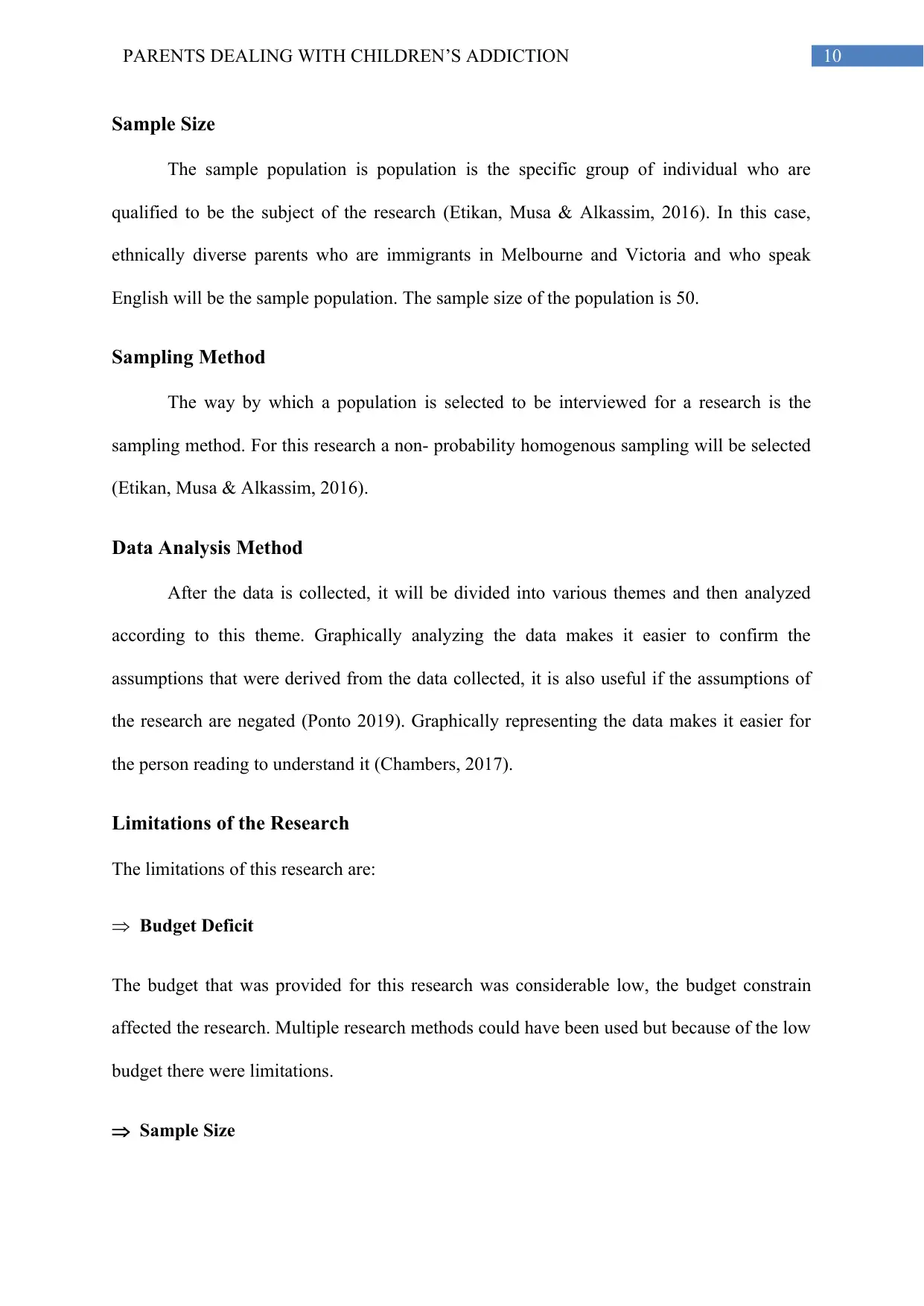
10PARENTS DEALING WITH CHILDREN’S ADDICTION
Sample Size
The sample population is population is the specific group of individual who are
qualified to be the subject of the research (Etikan, Musa & Alkassim, 2016). In this case,
ethnically diverse parents who are immigrants in Melbourne and Victoria and who speak
English will be the sample population. The sample size of the population is 50.
Sampling Method
The way by which a population is selected to be interviewed for a research is the
sampling method. For this research a non- probability homogenous sampling will be selected
(Etikan, Musa & Alkassim, 2016).
Data Analysis Method
After the data is collected, it will be divided into various themes and then analyzed
according to this theme. Graphically analyzing the data makes it easier to confirm the
assumptions that were derived from the data collected, it is also useful if the assumptions of
the research are negated (Ponto 2019). Graphically representing the data makes it easier for
the person reading to understand it (Chambers, 2017).
Limitations of the Research
The limitations of this research are:
Budget Deficit
The budget that was provided for this research was considerable low, the budget constrain
affected the research. Multiple research methods could have been used but because of the low
budget there were limitations.
Sample Size
Sample Size
The sample population is population is the specific group of individual who are
qualified to be the subject of the research (Etikan, Musa & Alkassim, 2016). In this case,
ethnically diverse parents who are immigrants in Melbourne and Victoria and who speak
English will be the sample population. The sample size of the population is 50.
Sampling Method
The way by which a population is selected to be interviewed for a research is the
sampling method. For this research a non- probability homogenous sampling will be selected
(Etikan, Musa & Alkassim, 2016).
Data Analysis Method
After the data is collected, it will be divided into various themes and then analyzed
according to this theme. Graphically analyzing the data makes it easier to confirm the
assumptions that were derived from the data collected, it is also useful if the assumptions of
the research are negated (Ponto 2019). Graphically representing the data makes it easier for
the person reading to understand it (Chambers, 2017).
Limitations of the Research
The limitations of this research are:
Budget Deficit
The budget that was provided for this research was considerable low, the budget constrain
affected the research. Multiple research methods could have been used but because of the low
budget there were limitations.
Sample Size
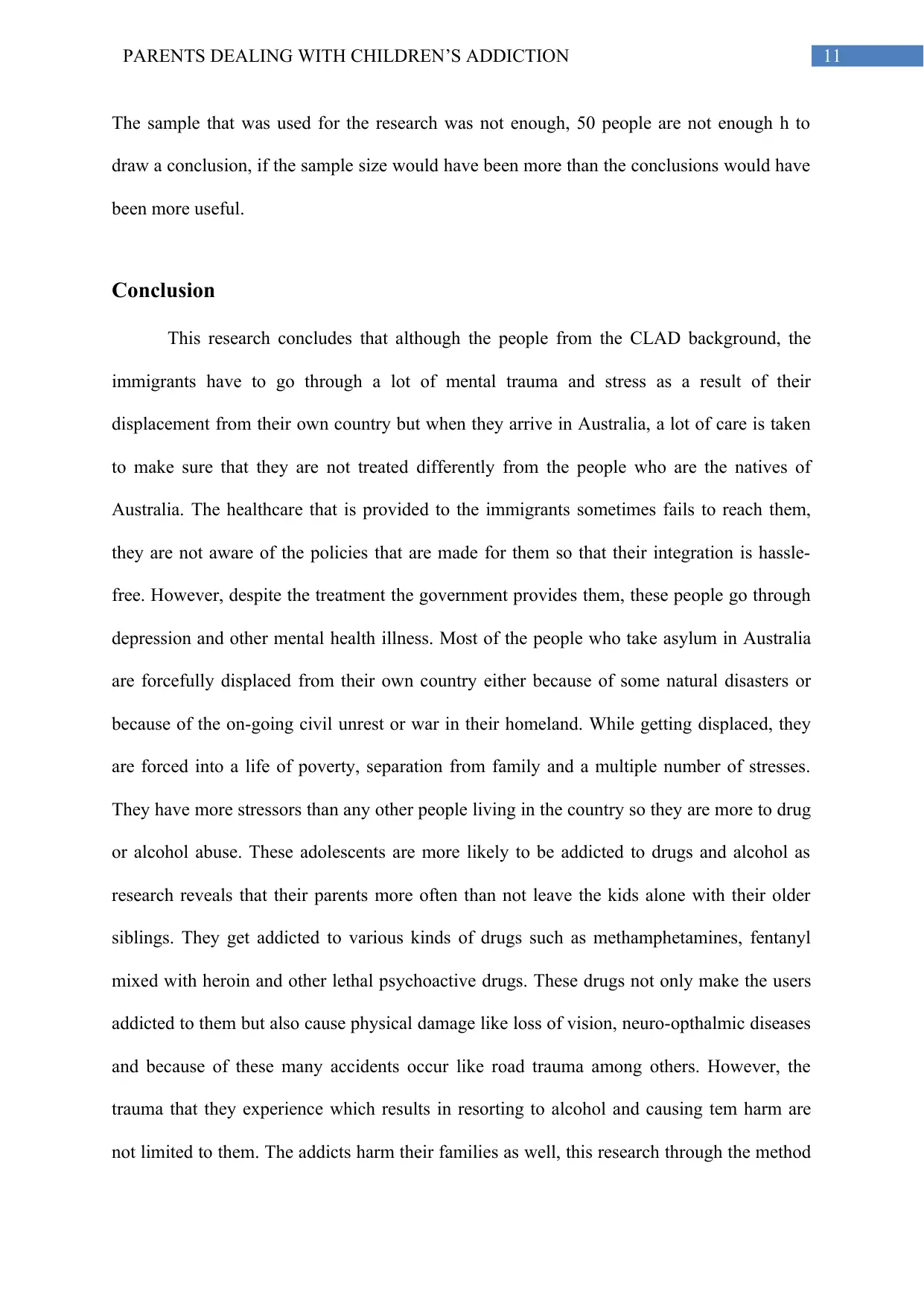
11PARENTS DEALING WITH CHILDREN’S ADDICTION
The sample that was used for the research was not enough, 50 people are not enough h to
draw a conclusion, if the sample size would have been more than the conclusions would have
been more useful.
Conclusion
This research concludes that although the people from the CLAD background, the
immigrants have to go through a lot of mental trauma and stress as a result of their
displacement from their own country but when they arrive in Australia, a lot of care is taken
to make sure that they are not treated differently from the people who are the natives of
Australia. The healthcare that is provided to the immigrants sometimes fails to reach them,
they are not aware of the policies that are made for them so that their integration is hassle-
free. However, despite the treatment the government provides them, these people go through
depression and other mental health illness. Most of the people who take asylum in Australia
are forcefully displaced from their own country either because of some natural disasters or
because of the on-going civil unrest or war in their homeland. While getting displaced, they
are forced into a life of poverty, separation from family and a multiple number of stresses.
They have more stressors than any other people living in the country so they are more to drug
or alcohol abuse. These adolescents are more likely to be addicted to drugs and alcohol as
research reveals that their parents more often than not leave the kids alone with their older
siblings. They get addicted to various kinds of drugs such as methamphetamines, fentanyl
mixed with heroin and other lethal psychoactive drugs. These drugs not only make the users
addicted to them but also cause physical damage like loss of vision, neuro-opthalmic diseases
and because of these many accidents occur like road trauma among others. However, the
trauma that they experience which results in resorting to alcohol and causing tem harm are
not limited to them. The addicts harm their families as well, this research through the method
The sample that was used for the research was not enough, 50 people are not enough h to
draw a conclusion, if the sample size would have been more than the conclusions would have
been more useful.
Conclusion
This research concludes that although the people from the CLAD background, the
immigrants have to go through a lot of mental trauma and stress as a result of their
displacement from their own country but when they arrive in Australia, a lot of care is taken
to make sure that they are not treated differently from the people who are the natives of
Australia. The healthcare that is provided to the immigrants sometimes fails to reach them,
they are not aware of the policies that are made for them so that their integration is hassle-
free. However, despite the treatment the government provides them, these people go through
depression and other mental health illness. Most of the people who take asylum in Australia
are forcefully displaced from their own country either because of some natural disasters or
because of the on-going civil unrest or war in their homeland. While getting displaced, they
are forced into a life of poverty, separation from family and a multiple number of stresses.
They have more stressors than any other people living in the country so they are more to drug
or alcohol abuse. These adolescents are more likely to be addicted to drugs and alcohol as
research reveals that their parents more often than not leave the kids alone with their older
siblings. They get addicted to various kinds of drugs such as methamphetamines, fentanyl
mixed with heroin and other lethal psychoactive drugs. These drugs not only make the users
addicted to them but also cause physical damage like loss of vision, neuro-opthalmic diseases
and because of these many accidents occur like road trauma among others. However, the
trauma that they experience which results in resorting to alcohol and causing tem harm are
not limited to them. The addicts harm their families as well, this research through the method

12PARENTS DEALING WITH CHILDREN’S ADDICTION
of face-to-face interview points out the problems and the trauma that the parents of these
addicts go through and the way they support and help each other.
of face-to-face interview points out the problems and the trauma that the parents of these
addicts go through and the way they support and help each other.
Paraphrase This Document
Need a fresh take? Get an instant paraphrase of this document with our AI Paraphraser
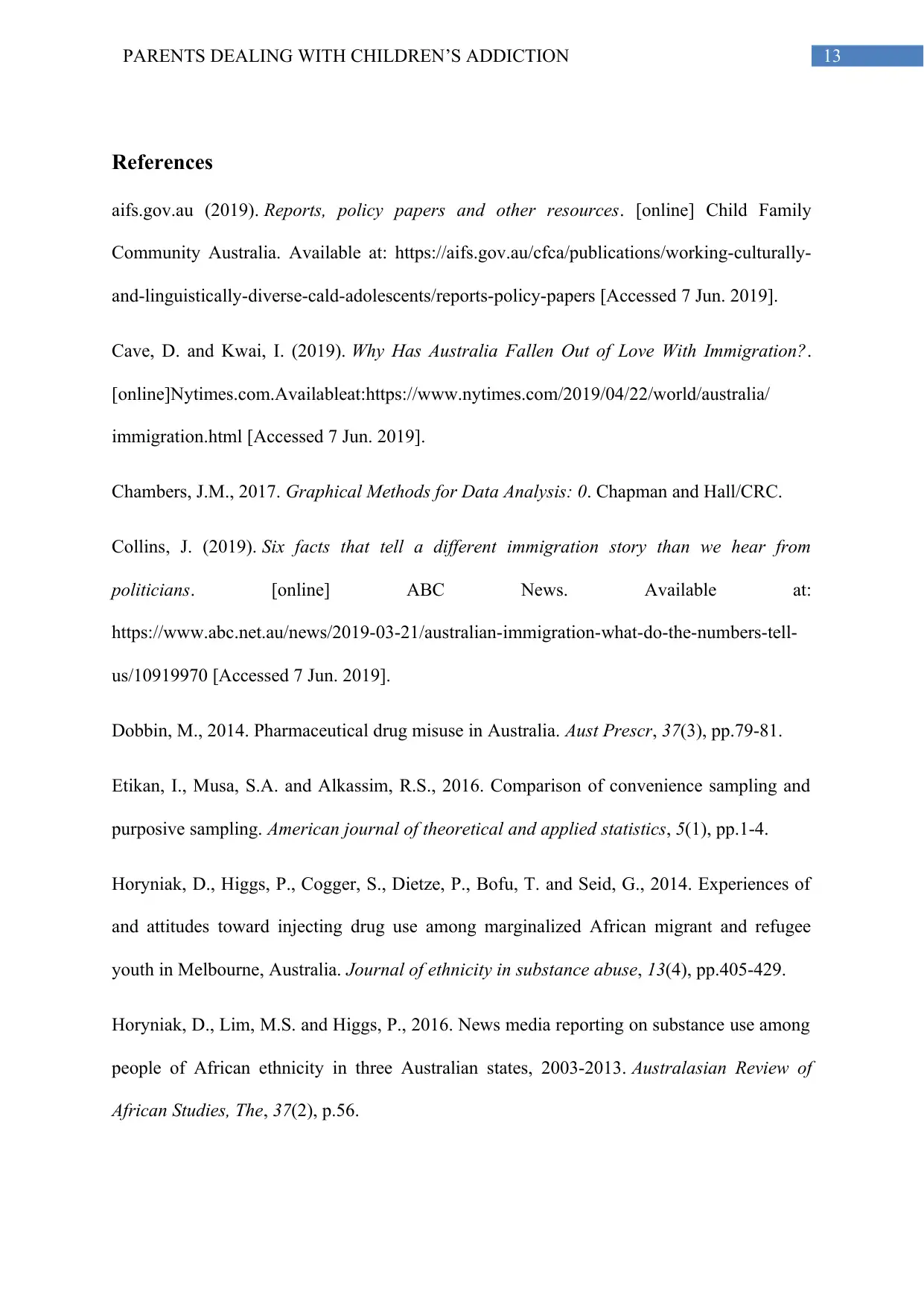
13PARENTS DEALING WITH CHILDREN’S ADDICTION
References
aifs.gov.au (2019). Reports, policy papers and other resources. [online] Child Family
Community Australia. Available at: https://aifs.gov.au/cfca/publications/working-culturally-
and-linguistically-diverse-cald-adolescents/reports-policy-papers [Accessed 7 Jun. 2019].
Cave, D. and Kwai, I. (2019). Why Has Australia Fallen Out of Love With Immigration?.
[online]Nytimes.com.Availableat:https://www.nytimes.com/2019/04/22/world/australia/
immigration.html [Accessed 7 Jun. 2019].
Chambers, J.M., 2017. Graphical Methods for Data Analysis: 0. Chapman and Hall/CRC.
Collins, J. (2019). Six facts that tell a different immigration story than we hear from
politicians. [online] ABC News. Available at:
https://www.abc.net.au/news/2019-03-21/australian-immigration-what-do-the-numbers-tell-
us/10919970 [Accessed 7 Jun. 2019].
Dobbin, M., 2014. Pharmaceutical drug misuse in Australia. Aust Prescr, 37(3), pp.79-81.
Etikan, I., Musa, S.A. and Alkassim, R.S., 2016. Comparison of convenience sampling and
purposive sampling. American journal of theoretical and applied statistics, 5(1), pp.1-4.
Horyniak, D., Higgs, P., Cogger, S., Dietze, P., Bofu, T. and Seid, G., 2014. Experiences of
and attitudes toward injecting drug use among marginalized African migrant and refugee
youth in Melbourne, Australia. Journal of ethnicity in substance abuse, 13(4), pp.405-429.
Horyniak, D., Lim, M.S. and Higgs, P., 2016. News media reporting on substance use among
people of African ethnicity in three Australian states, 2003-2013. Australasian Review of
African Studies, The, 37(2), p.56.
References
aifs.gov.au (2019). Reports, policy papers and other resources. [online] Child Family
Community Australia. Available at: https://aifs.gov.au/cfca/publications/working-culturally-
and-linguistically-diverse-cald-adolescents/reports-policy-papers [Accessed 7 Jun. 2019].
Cave, D. and Kwai, I. (2019). Why Has Australia Fallen Out of Love With Immigration?.
[online]Nytimes.com.Availableat:https://www.nytimes.com/2019/04/22/world/australia/
immigration.html [Accessed 7 Jun. 2019].
Chambers, J.M., 2017. Graphical Methods for Data Analysis: 0. Chapman and Hall/CRC.
Collins, J. (2019). Six facts that tell a different immigration story than we hear from
politicians. [online] ABC News. Available at:
https://www.abc.net.au/news/2019-03-21/australian-immigration-what-do-the-numbers-tell-
us/10919970 [Accessed 7 Jun. 2019].
Dobbin, M., 2014. Pharmaceutical drug misuse in Australia. Aust Prescr, 37(3), pp.79-81.
Etikan, I., Musa, S.A. and Alkassim, R.S., 2016. Comparison of convenience sampling and
purposive sampling. American journal of theoretical and applied statistics, 5(1), pp.1-4.
Horyniak, D., Higgs, P., Cogger, S., Dietze, P., Bofu, T. and Seid, G., 2014. Experiences of
and attitudes toward injecting drug use among marginalized African migrant and refugee
youth in Melbourne, Australia. Journal of ethnicity in substance abuse, 13(4), pp.405-429.
Horyniak, D., Lim, M.S. and Higgs, P., 2016. News media reporting on substance use among
people of African ethnicity in three Australian states, 2003-2013. Australasian Review of
African Studies, The, 37(2), p.56.
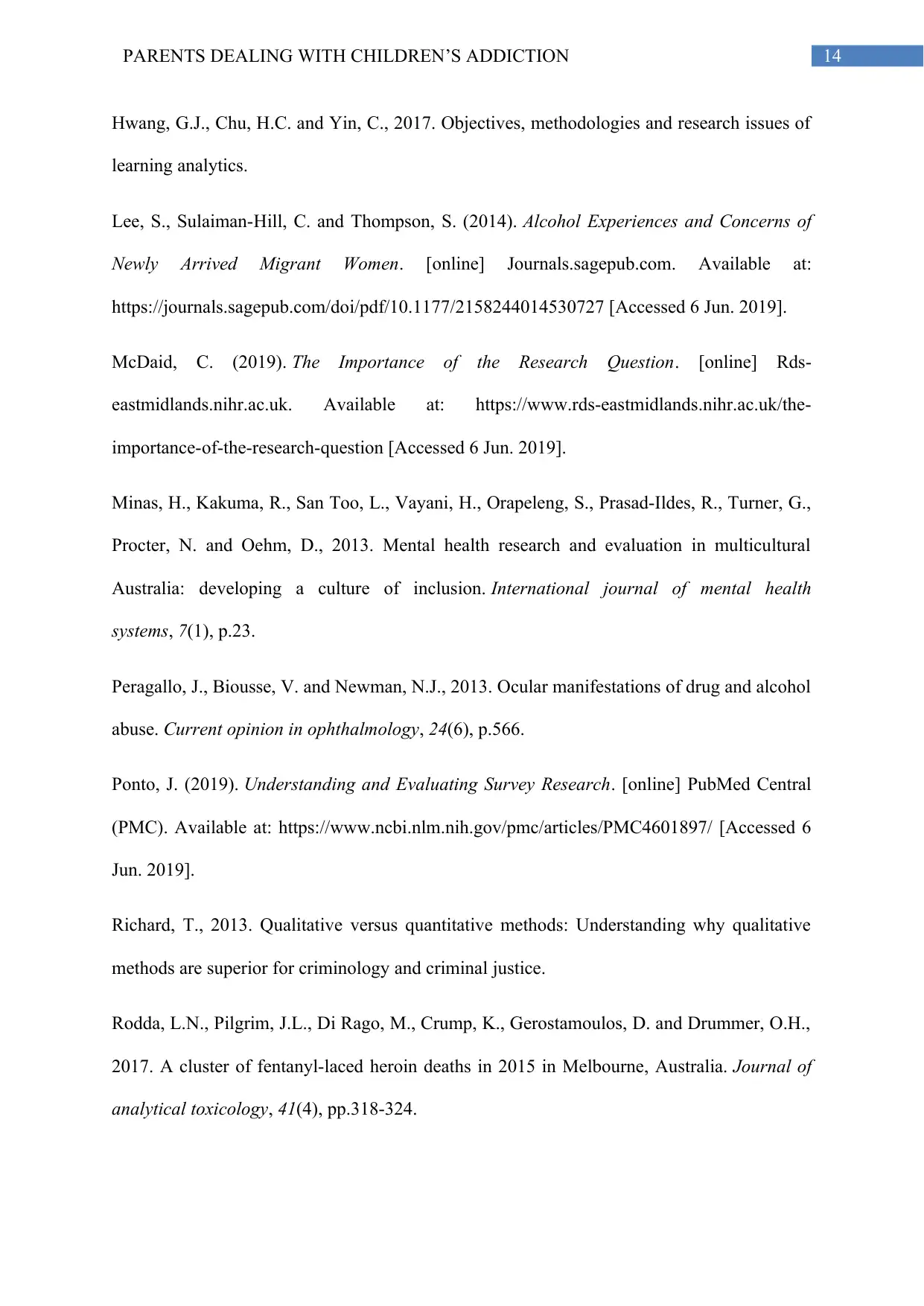
14PARENTS DEALING WITH CHILDREN’S ADDICTION
Hwang, G.J., Chu, H.C. and Yin, C., 2017. Objectives, methodologies and research issues of
learning analytics.
Lee, S., Sulaiman-Hill, C. and Thompson, S. (2014). Alcohol Experiences and Concerns of
Newly Arrived Migrant Women. [online] Journals.sagepub.com. Available at:
https://journals.sagepub.com/doi/pdf/10.1177/2158244014530727 [Accessed 6 Jun. 2019].
McDaid, C. (2019). The Importance of the Research Question. [online] Rds-
eastmidlands.nihr.ac.uk. Available at: https://www.rds-eastmidlands.nihr.ac.uk/the-
importance-of-the-research-question [Accessed 6 Jun. 2019].
Minas, H., Kakuma, R., San Too, L., Vayani, H., Orapeleng, S., Prasad-Ildes, R., Turner, G.,
Procter, N. and Oehm, D., 2013. Mental health research and evaluation in multicultural
Australia: developing a culture of inclusion. International journal of mental health
systems, 7(1), p.23.
Peragallo, J., Biousse, V. and Newman, N.J., 2013. Ocular manifestations of drug and alcohol
abuse. Current opinion in ophthalmology, 24(6), p.566.
Ponto, J. (2019). Understanding and Evaluating Survey Research. [online] PubMed Central
(PMC). Available at: https://www.ncbi.nlm.nih.gov/pmc/articles/PMC4601897/ [Accessed 6
Jun. 2019].
Richard, T., 2013. Qualitative versus quantitative methods: Understanding why qualitative
methods are superior for criminology and criminal justice.
Rodda, L.N., Pilgrim, J.L., Di Rago, M., Crump, K., Gerostamoulos, D. and Drummer, O.H.,
2017. A cluster of fentanyl-laced heroin deaths in 2015 in Melbourne, Australia. Journal of
analytical toxicology, 41(4), pp.318-324.
Hwang, G.J., Chu, H.C. and Yin, C., 2017. Objectives, methodologies and research issues of
learning analytics.
Lee, S., Sulaiman-Hill, C. and Thompson, S. (2014). Alcohol Experiences and Concerns of
Newly Arrived Migrant Women. [online] Journals.sagepub.com. Available at:
https://journals.sagepub.com/doi/pdf/10.1177/2158244014530727 [Accessed 6 Jun. 2019].
McDaid, C. (2019). The Importance of the Research Question. [online] Rds-
eastmidlands.nihr.ac.uk. Available at: https://www.rds-eastmidlands.nihr.ac.uk/the-
importance-of-the-research-question [Accessed 6 Jun. 2019].
Minas, H., Kakuma, R., San Too, L., Vayani, H., Orapeleng, S., Prasad-Ildes, R., Turner, G.,
Procter, N. and Oehm, D., 2013. Mental health research and evaluation in multicultural
Australia: developing a culture of inclusion. International journal of mental health
systems, 7(1), p.23.
Peragallo, J., Biousse, V. and Newman, N.J., 2013. Ocular manifestations of drug and alcohol
abuse. Current opinion in ophthalmology, 24(6), p.566.
Ponto, J. (2019). Understanding and Evaluating Survey Research. [online] PubMed Central
(PMC). Available at: https://www.ncbi.nlm.nih.gov/pmc/articles/PMC4601897/ [Accessed 6
Jun. 2019].
Richard, T., 2013. Qualitative versus quantitative methods: Understanding why qualitative
methods are superior for criminology and criminal justice.
Rodda, L.N., Pilgrim, J.L., Di Rago, M., Crump, K., Gerostamoulos, D. and Drummer, O.H.,
2017. A cluster of fentanyl-laced heroin deaths in 2015 in Melbourne, Australia. Journal of
analytical toxicology, 41(4), pp.318-324.
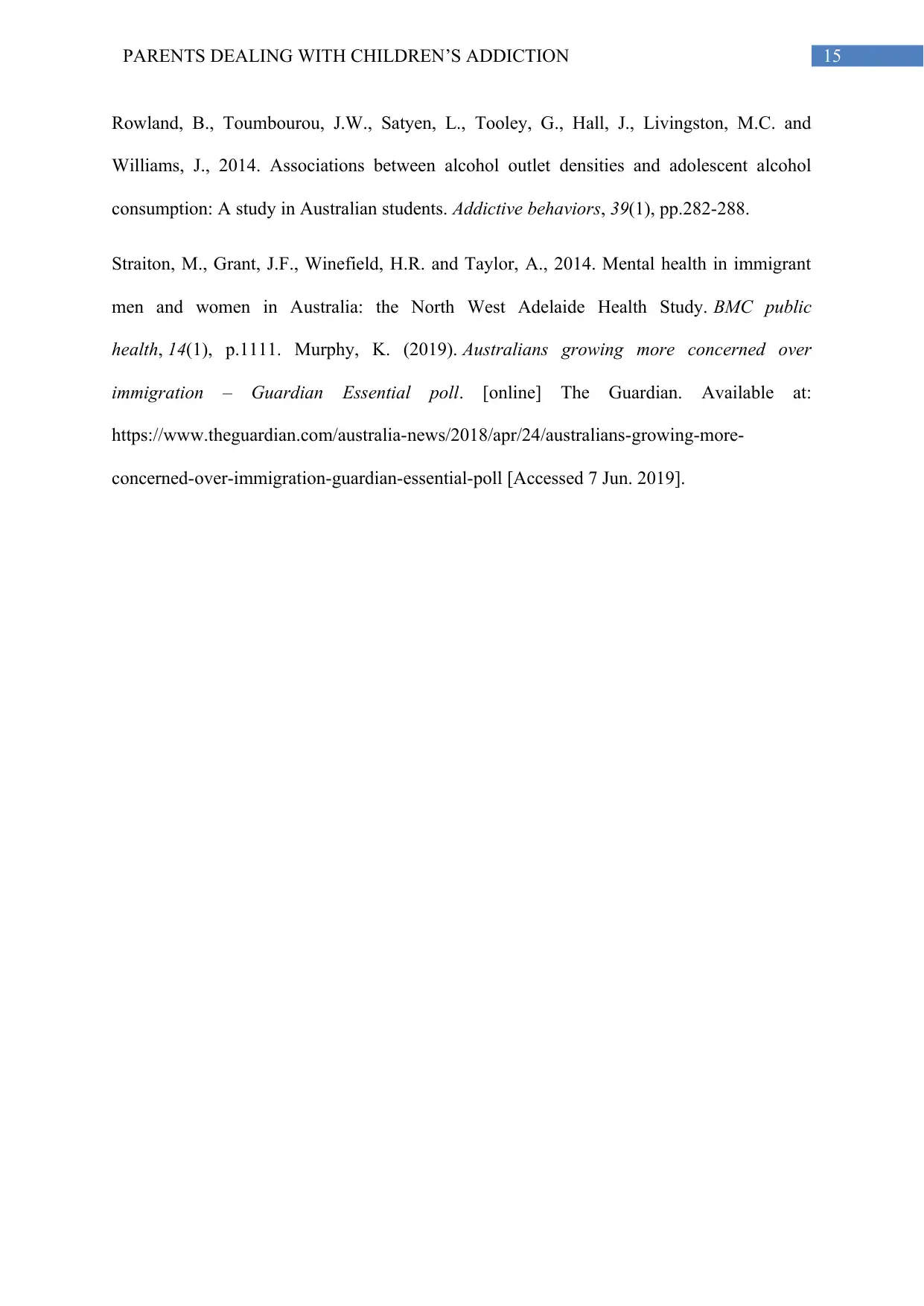
15PARENTS DEALING WITH CHILDREN’S ADDICTION
Rowland, B., Toumbourou, J.W., Satyen, L., Tooley, G., Hall, J., Livingston, M.C. and
Williams, J., 2014. Associations between alcohol outlet densities and adolescent alcohol
consumption: A study in Australian students. Addictive behaviors, 39(1), pp.282-288.
Straiton, M., Grant, J.F., Winefield, H.R. and Taylor, A., 2014. Mental health in immigrant
men and women in Australia: the North West Adelaide Health Study. BMC public
health, 14(1), p.1111. Murphy, K. (2019). Australians growing more concerned over
immigration – Guardian Essential poll. [online] The Guardian. Available at:
https://www.theguardian.com/australia-news/2018/apr/24/australians-growing-more-
concerned-over-immigration-guardian-essential-poll [Accessed 7 Jun. 2019].
Rowland, B., Toumbourou, J.W., Satyen, L., Tooley, G., Hall, J., Livingston, M.C. and
Williams, J., 2014. Associations between alcohol outlet densities and adolescent alcohol
consumption: A study in Australian students. Addictive behaviors, 39(1), pp.282-288.
Straiton, M., Grant, J.F., Winefield, H.R. and Taylor, A., 2014. Mental health in immigrant
men and women in Australia: the North West Adelaide Health Study. BMC public
health, 14(1), p.1111. Murphy, K. (2019). Australians growing more concerned over
immigration – Guardian Essential poll. [online] The Guardian. Available at:
https://www.theguardian.com/australia-news/2018/apr/24/australians-growing-more-
concerned-over-immigration-guardian-essential-poll [Accessed 7 Jun. 2019].
Secure Best Marks with AI Grader
Need help grading? Try our AI Grader for instant feedback on your assignments.
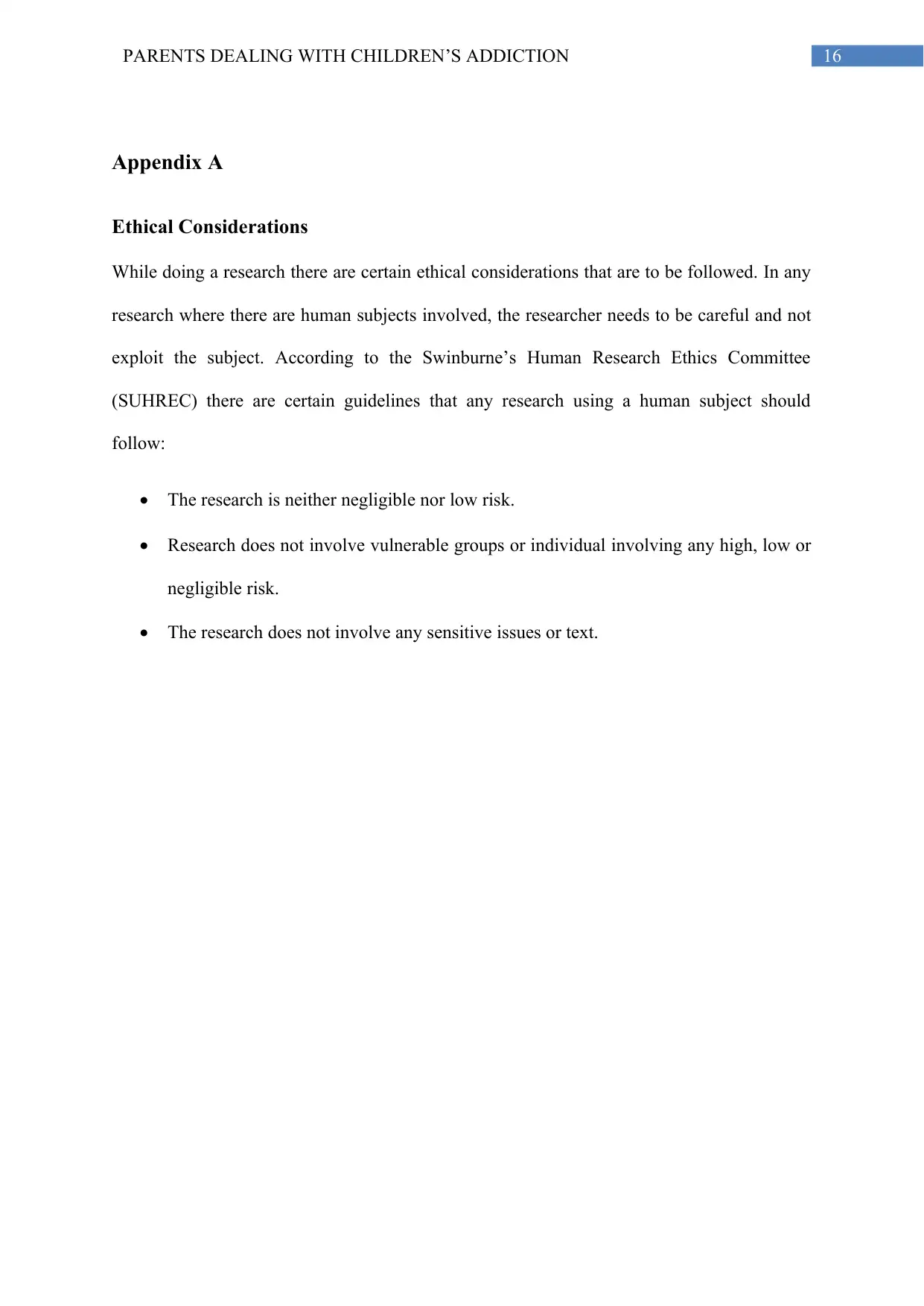
16PARENTS DEALING WITH CHILDREN’S ADDICTION
Appendix A
Ethical Considerations
While doing a research there are certain ethical considerations that are to be followed. In any
research where there are human subjects involved, the researcher needs to be careful and not
exploit the subject. According to the Swinburne’s Human Research Ethics Committee
(SUHREC) there are certain guidelines that any research using a human subject should
follow:
The research is neither negligible nor low risk.
Research does not involve vulnerable groups or individual involving any high, low or
negligible risk.
The research does not involve any sensitive issues or text.
Appendix A
Ethical Considerations
While doing a research there are certain ethical considerations that are to be followed. In any
research where there are human subjects involved, the researcher needs to be careful and not
exploit the subject. According to the Swinburne’s Human Research Ethics Committee
(SUHREC) there are certain guidelines that any research using a human subject should
follow:
The research is neither negligible nor low risk.
Research does not involve vulnerable groups or individual involving any high, low or
negligible risk.
The research does not involve any sensitive issues or text.
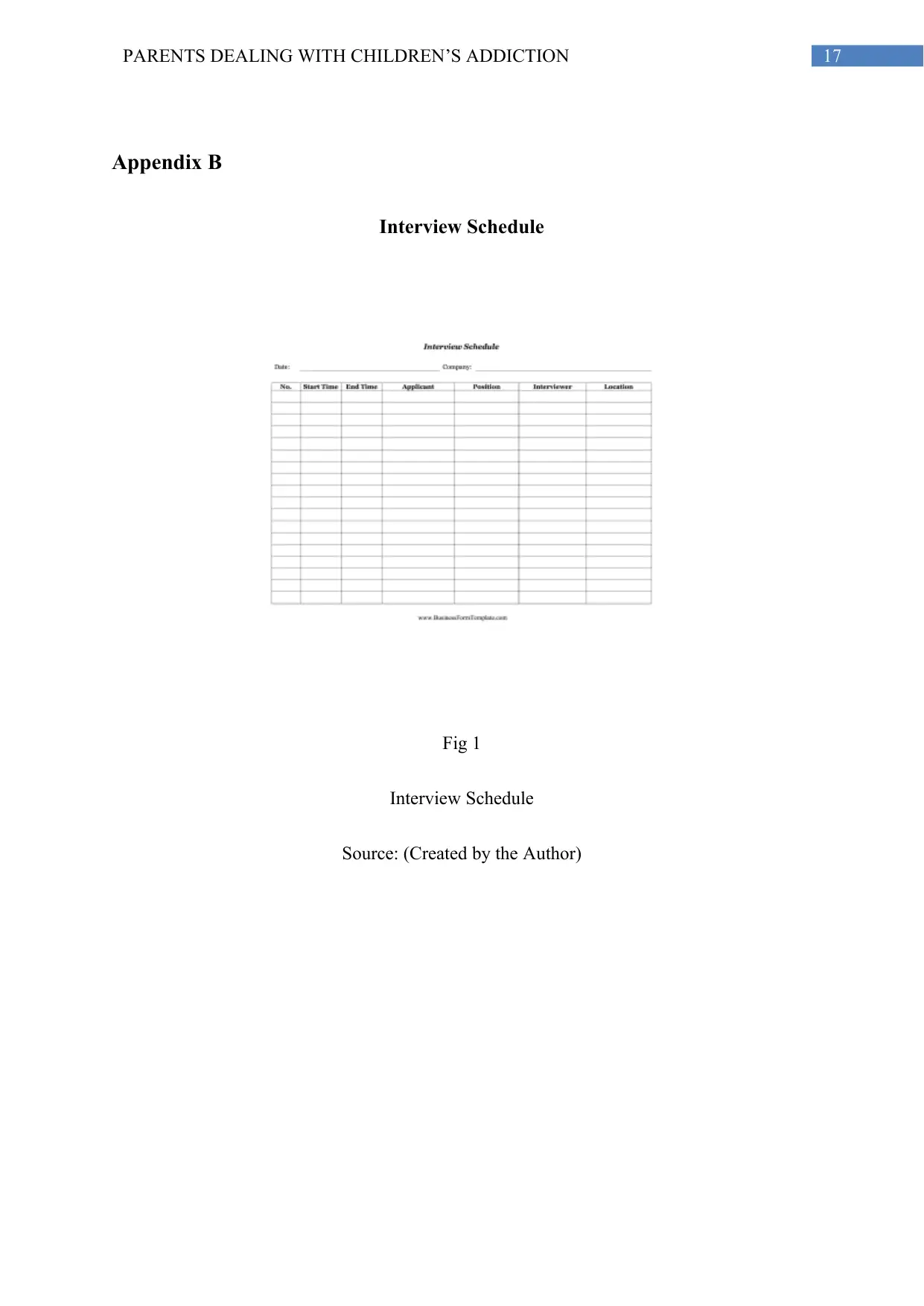
17PARENTS DEALING WITH CHILDREN’S ADDICTION
Appendix B
Interview Schedule
Fig 1
Interview Schedule
Source: (Created by the Author)
Appendix B
Interview Schedule
Fig 1
Interview Schedule
Source: (Created by the Author)
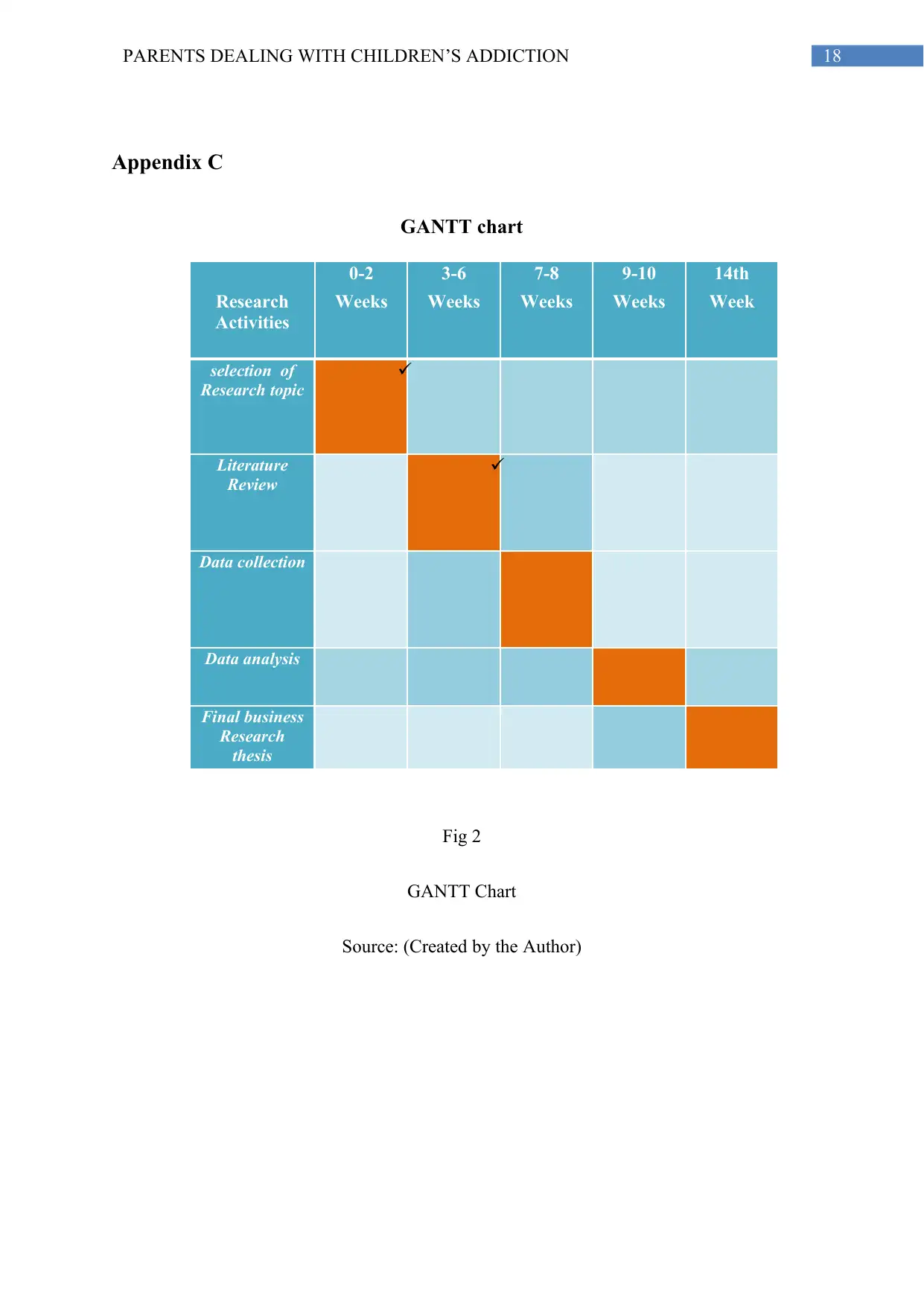
18PARENTS DEALING WITH CHILDREN’S ADDICTION
Appendix C
GANTT chart
0-2 3-6 7-8 9-10 14th
Research
Activities
Weeks Weeks Weeks Weeks Week
selection of
Research topic
Literature
Review
Data collection
Data analysis
Final business
Research
thesis
Fig 2
GANTT Chart
Source: (Created by the Author)
Appendix C
GANTT chart
0-2 3-6 7-8 9-10 14th
Research
Activities
Weeks Weeks Weeks Weeks Week
selection of
Research topic
Literature
Review
Data collection
Data analysis
Final business
Research
thesis
Fig 2
GANTT Chart
Source: (Created by the Author)
1 out of 19
Related Documents
Your All-in-One AI-Powered Toolkit for Academic Success.
+13062052269
info@desklib.com
Available 24*7 on WhatsApp / Email
![[object Object]](/_next/static/media/star-bottom.7253800d.svg)
Unlock your academic potential
© 2024 | Zucol Services PVT LTD | All rights reserved.




